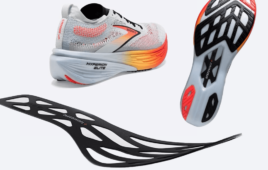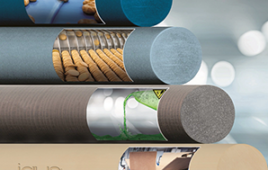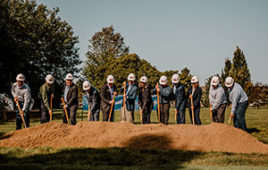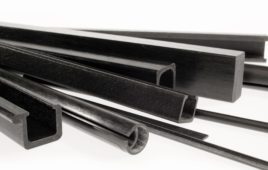MIT graduate student Leon Dimas is no stranger to resilience: At 18, as a rising soccer star, the long-armed goalkeeper was a promising prospect who played for the youth academy of Rosenborg BK, a top-ranked Norwegian soccer club. He was set, it seemed, on a path that would allow him to pursue a professional career playing the game that was his first love.
But when Dimas suffered nagging damage to a shoulder tendon, his professional prospects dimmed. Over the course of the next year, he made the decision to abandon professional soccer for good. “Once that dream broke, you wonder if you can get these kinds of feelings again,” Dimas says, “feelings of accomplishment and that someone believes in you.”
It’s fair to say that Dimas, now a doctoral student in MIT’s Department of Civil and Environmental Engineering, has bounced back. Fittingly, he is now working on creating new materials that have resilience of their own — by borrowing from the oldest blueprint around.
“The main idea is to look into nature,” Dimas says, “specifically, investigating mineralized composites and trying to understand why they perform so well.”
Biomaterials such as bone and nacre (also known as mother-of-pearl) remain robust even in the presence of cracks, defects, or other flaws. Such materials are composed of brittle minerals and soft proteins — ingredients that are weak, but exhibit strength when combined in hierarchical geometries. In bone, for example, the brittle mineral apatite and the soft protein collagen are arranged in patterns that yield a strong and tough composite.
In a series of interrelated papers, the most recent of which was published last year in Advanced Functional Materials, Dimas and other researchers — including his advisor, Professor Markus Buehler, head of MIT’s Department of Civil and Environmental Engineering — created models that predicted the fracture response, fracture resistance, and durability of synthetic materials that arranged their ingredients in various natural and synthetic geometries. In the most recent paper, the researchers showed that they could efficiently 3-D print such materials, and that their model accurately predicted the resulting material’s properties.
Such research could eventually lead to new “metamaterials” that combine nature’s designs with human engineering — resulting in cars, or whole buildings, constructed from superstrong synthetic skeletons.
“The limit is having a material with flaws that behaves as though it is pristine,” Dimas says. “With an improved understanding of how these cracks act and how we can mitigate their consequences, we can shoot for more high-performing and more lightweight structures — using less material, more efficiently.”
Athletics to academics
Dimas’ favorite subject in school was always mathematics, but, he says, “Without the pressure of my parents I doubt that I would have pursued it as much as I have done now. I wanted to play soccer. I didn’t want to do my homework.”
His soccer career had humble beginnings: His older brother wanted someone to shoot the ball at, so Dimas found a pair of leather gloves and took on the role of goalkeeper. “From when I could walk I was probably playing close to every day,” he says.
The family was living in New Jersey at the time, while Dimas’ father completed his PhD in philosophy at Princeton University. After finishing, they moved to England, where Dimas, at age 8, began to get serious about soccer. He was allowed to try out for an elite English youth academy, and although his family moved to Norway shortly thereafter, he had caught the bug. If he didn’t have team practice, he would play on his own, pounding a ball into a net or kicking it off a concrete wall over and over — taking advantage of the random ricochet provided by the wall’s imperfections, forcing him to practice his footwork.
His family made sure school remained a priority. During his last year of high school, when Dimas was preparing for exams by taking practice tests, his parents were unimpressed by his progress. “My grades were not great,” he says. “And my parents said, ‘All right: You’re going to go into this room right now and you’re going to stay. You can play your games, but you’re not going to practice.’”
Dimas skipped practice for nearly a month, and his preparation worked: He aced his tests and matriculated in a five-year master’s program in structural engineering at Norwegian University of Science and Technology (NTNU), still juggling soccer alongside school. “It’s actually quite unusual to pursue an education at the same time as you’re pursuing your [soccer] career,” he says. “It kind of meant that I’d be missing half my lectures because we’d have practice in the morning. Sometimes we’d have two practices a day.”
Then, in the fourth year of his program, after veering from the professional soccer trajectory, Dimas took a year abroad to study at MIT. “I came here in August and by late September I was determined I wanted to stay,” he says. “In October I was already starting to apply. So it didn’t take me long to decide that this was the place that I really wanted to be.”
What particularly struck Dimas was the hands-on, personal nature of learning at MIT. His master’s program at NTNU was “more of an engineering training school, while [at MIT] it seems like more of a scientific exploration,” he says. “It’s a very motivating thing when you have these very renowned professors that are actually interested in discussing things with you. It makes you want to contribute and it makes you feel like you can contribute.”
After impressing faculty during his time at MIT, the good news came. “There was a Friday afternoon in March that I was emailed that I was going to be accepted,” he says. “Later I got the letter of acceptance, and I have yet to open it. And I’m kind of saving it for a bad day, because that was big. That really meant a lot to me.”
Teaching through thinking
When Dimas came to MIT, he soon realized that an important activity was missing: At NTNU, he had been a teaching assistant, which he loved. “My TA sessions were the highlight of my week,” he says. “You get to accompany your colleagues on a journey from not understanding to understanding. And you know that you have been able to help them through this journey.”
Dimas wanted to continue teaching, but with a different focus. In 2012, he founded MITxplore with two other MIT graduate students and funding from the MIT Public Service Center. The organization, which is run entirely by MIT students, holds afterschool programs for 50 fifth-graders in three different locations in Cambridge and Boston. The goal is to encourage learning in math through experimentation and exploration.
“I don’t care too much if [the students] learn a specific concept or understand a specific engineering phenomenon,” Dimas says. “I just want them to think, and become confident that they can put themselves on the path from not understanding to understanding. Understanding is the most empowering thing.”
They often explore difficult concepts using simple materials — such as an exercise that involves squeezing Play-Doh through a nozzle that can vary in size. The students note that the narrower the nozzle diameter, the longer the Play-Doh string.
Then the instructors pose a question: What if we could make the nozzle as small as we wanted? Could we make the Play-Doh string as long as we wanted? “And just like that, all of a sudden they’re exploring this concept of infinity,” Dimas says. “And that is, I’d say, a pretty complex concept for a 10-year-old to understand.”
Filed Under: Materials • advanced




